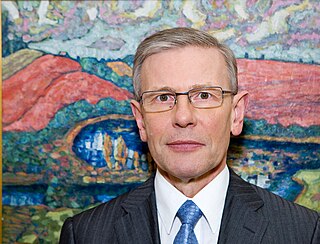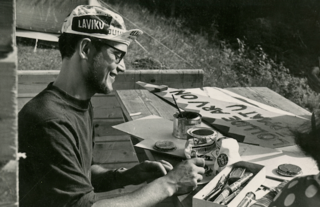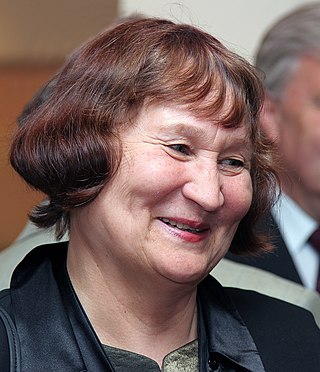Related Research Articles

Ilya Iosifovich Kabakov was an American and Soviet conceptual artist, born in Dnipropetrovsk in what was then the Ukrainian SSR of the Soviet Union, now Ukraine. He worked for thirty years in Moscow, from the 1950s until the late 1980s. After emigrating to the United States he lived and worked on Long Island.
Soviet nonconformist art was Soviet art produced in the former Soviet Union outside the control of the Soviet state started in the Stalinist era, in particular, outside of the rubric of Socialist Realism. Other terms used to refer to this phenomenon are Soviet counterculture, "underground art" or "unofficial art".

The Bulldozer Exhibition was an unofficial art exhibition on a vacant lot in the Belyayevo urban forest by Moscow and Leningrad avant-garde artists on 15 September 1974. The exhibition was forcefully broken-up by a large police force that included bulldozers and water cannons, hence the name.

The Estonian Academy of Arts is the only public university in Estonia providing higher education in art, design, architecture, media, art history and conservation-restoration. It is based in Tallinn.
Ülo Ilmar Sooster was an Estonian nonconformist painter.

Culture Factory Polymer was a multidisciplinary centre for artistic creation and diffusion in Tallinn, Estonia. Located in Lilleküla, Kristiine District, on the fringes of the Tallinn city centre, this former toy factory became in 2003 one of the main strong points for alternative un-institutionalized culture in Tallinn.

Leonhard Lapin, also known under the pseudonym Albert Trapeež, was an Estonian architect, artist, architecture historian, and poet.

Estonia, officially the Republic of Estonia, is a country by the Baltic Sea in Northern Europe. It is bordered to the north by the Gulf of Finland across from Finland, to the west by the sea across from Sweden, to the south by Latvia, and to the east by Russia. The territory of Estonia consists of the mainland, the larger islands of Saaremaa and Hiiumaa, and over 2,300 other islands and islets on the east coast of the Baltic Sea, covering a total area of 45,335 square kilometres (17,504 sq mi). Tallinn and Tartu are the two largest urban areas. The Estonian language is the official language and the first language of the majority of the population of 1.4 million.
Tõnis Vint was an Estonian graphic artist, considered by some to have been one of the most important artists of the 1960s to 1980s in Estonia.

Alexander Aksinin was a Soviet printmaker and painter. His sophisticated etching technique, precision and perfectionist attention to details earned him the sobriquet the “Dürer of Lviv”. Art critics hailed him as “a 20th century Piranesi” for his dramatic and elaborate constructs.

Enn Kunila is an Estonian entrepreneur and art collector.

Georgy Kiesewalter is a Russian conceptual artist, photographer and essayist, working in different artistic areas from painting to graphic art, from installations to conceptual photography and digital art.
Malle Leis was an Estonian painter and graphic artist. Her works mostly represent abstract forms in nature, including flowers, fruits, and vegetables. She developed a silk screen technique that became her trademark.

Eye in the Egg is a 1962 oil on paper painting by the Estonian artist Ülo Sooster in the Tartu Art Museum.
Estonian art is art that comes from Estonia, from Estonian artists or art pieces relating to Estonia. Starting from prehistoric art, there are no caves with paintings in Estonia. About 1700 registered cup stones have been found from the Bronze Age and archaeological finds from the neolithic period. Nearest two caves with Paleolithic paintings are in Southern Ural mountains in Bashkortostan and Russia. In Finland have founded over 100 rock paintings sites in vertical walls of granite rocks... but no caves. Neolithic rock carvings have been preserved in granite rocks on the Eastern coast of Lake Onega, also in the White Sea region, on Kola peninsula, Northern Norway and Southern Sweden etc..

Kaarel Kurismaa is the first and one of the most important sound art and sound installation artists in Estonia. His work also expands into the field of painting, animation, public space monumental art, stage installations. In Estonian art history, Kurismaa’s significance lies mostly in the pioneering work with kinetic art and with keeping its traditions alive. Kurismaa stands as one of Estonian sound art scene’s central icons. His idiosyncratic work serves as a foundation for Estonian sound and kinetic art.

Mare Vint was an Estonian graphic artist. In her work, Vint mostly depicted an "ideal landscape".
Enno Ootsing is an Estonian artist and academic. He has worked as a freelance graphic artist and designer, book artist and illustrator. In 1980, he became a lecturer at the Estonian Academy of Arts, and from 1984 until 2005, he was a professor and head of the graphics department of the institute. Since 2007 he has been a professor emeritus at the institute.

Aili Vint is an Estonian graphic designer and painter.
Lepo Mikko was an Estonian painter and teacher.
References
- ↑ "Estonian encyclopedia". Archived from the original on 2013-10-04. Retrieved 2016-05-14.
- ↑ ANK group discussed by Eda Sepp in Estonian Non-conformist art from the Soviet occupation in 1944 to Perestroika, p. 67 in chapter 2 in Art of the Baltics: The Struggle for Freedom of Artistic Expression under the Soviets, 1945-1991, edited by Jane Voorhees, Alla Rosenfeld and Norton T. Dodge, exhibition catalog Zimmerli Art Museum, Rutgers University, New Brunswick, New Jersey, 2001/2002, ISBN 978-0813530420